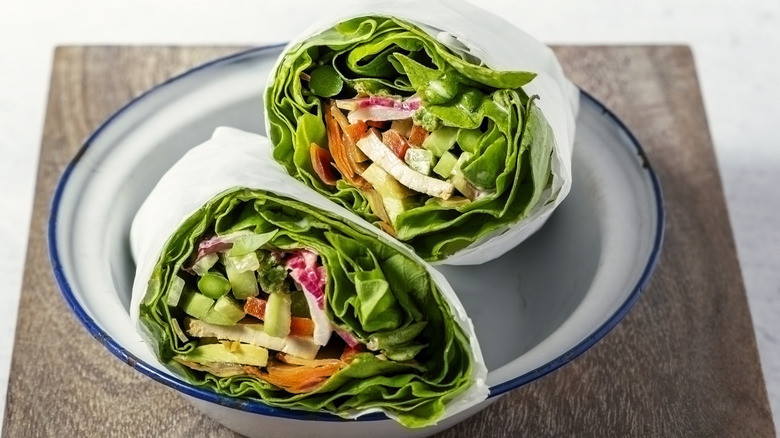The Best Leafy Greens To Convert Your Sandwich Into A Lettuce Wrap
If you still think a wrap consists of a bunch of yummy ingredients rolled up inside a carb-loaded tortilla, it's time to let go of the past and embrace a different way of eating. Lettuce wraps are not only good for you, but they are refreshing, easy to make, and let you get creative with your food. And the best part about them is that you have plenty of options when it comes to the type of lettuce you can use.
Not all lettuce will work for a wrap — you want a variety that has leaves big enough to hold all your fillings without losing any errant bits (just like you would want to use if you were swapping a burger bun out for lettuce), but is still able to wrap nice and tight. Arugula, for example, might offer great nutritional value and lend a spicy bite to your lunch salad, but you won't be able to get a nice tight wrap out of the narrow, often pointy leaves, and while slept-on oakleaf lettuce is pretty and colorful, it's just too delicate. Instead, consider something with a big, flat leaf, such as iceberg, butter lettuce, red or green leaf lettuce, or even a nutrient-rich romaine.
Using one of these delicious greens will not only give you a nutrient-packed lunch but also allow you to experiment with your standard sandwich recipes and craft more comprehensive meals. For example, romaine will shine with a filling of grilled chicken tossed with shaved Parmesan and Caesar dressing, essentially giving you a salad in handheld form. You could also make a bread-free version of the viral Sprouts sandwich.
Tips for making a lettuce wrap like a pro
If one piece of lettuce isn't enough to hold all your ingredients, don't worry about using multiple leaves — just be sure to overlap them so your fillings don't fall out. And if you want to add some extra leafy greens rich in vitamins, like spinach, arugula, or baby kale, you can still add them to your wrap even if they can't be used around the outside. Simply layer them in along with your other fillings, like adding chopped spinach with feta cheese, rice, and dill for a Greek spanakopita-inspired wrap.
Once you've got your lettuce wrap all made, what should you do if you need it to go? Keep things tightly wrapped together by using a sheet of parchment paper. It maintains the moisture inside so your wrap still tastes fresh when you're ready to eat it; it also gives you something dry to hold onto while you eat rather than having to hold the lettuce directly in your hands. Pro Tip: When you are ready to wrap up your wrap to pack it for a to-go lunch, cut through the wrap with a sharp knife, but don't cut all the way through. This will help keep the insides from loosening up and falling out during travel but will still give you a wrap that can easily be split into halves so you can eat it with ease when you are ready.

